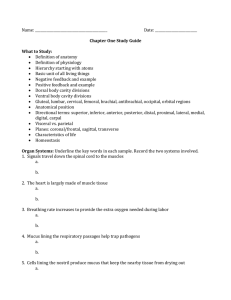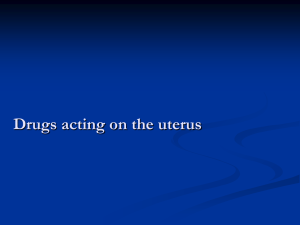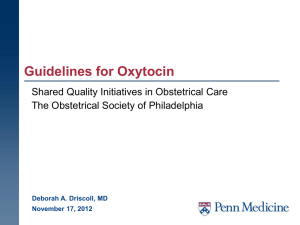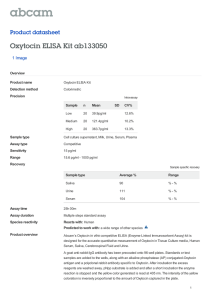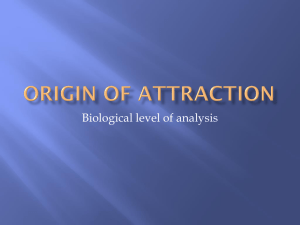Modelling the model systems Gareth Leng
advertisement
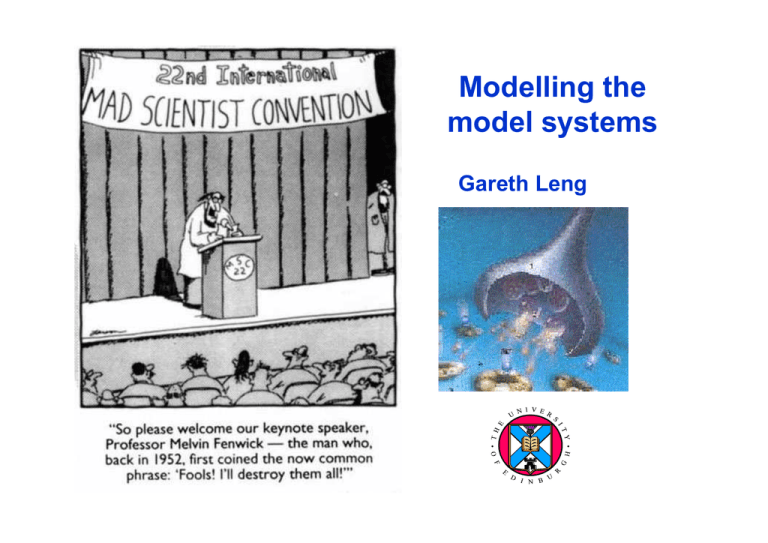
Modelling the model systems Gareth Leng Once upon a time, neurons were thought to communicate by transmitters that excited or inhibited other neurons. These signals were regulated by action potentials that evoked transmitter release at synapses, with short lasting effects. Information processing consisted of sophisticated spatio-temporal patterns of activation. GABA, glutamate, ACh and the catecholamines Peptides in the brain….. Oxytocin, vasopressin, cholecystokinin, opioids, tachykinins, GHRH, LHRH, TRH, CRF, somatostatin, NPY, orexins, substance P, apelin, CART, AgRP, PACAP, galanin, VIP, urocortin, PrRP, neurotensin, neuromedins, ANP, BNP, angiotensin, BDNF, ghrelin, MCH, a-MSH…. >100 so far Vasopressin Cells Supraoptic nucleus Neural lobe Spike activity Firing rate 30 Spikes/s 0 1 min Phasic firing is efficient for vasopressin secretion Secretion maximal at ~13 Hz (Dutton & Dyball 1977) … increases with burst duration up to ~20 s (Shaw et al. 1984) … fatigues at longer burst durations, reversed by silences Bicknell et al. (1984) In the neural lobe… 9,000 oxytocin cells and 9000 vasopressin cells project there. 9,000 vasopressin cells 1,840 endings 436 swellings Jean Nordmann (1976) John Morris (1976) 9,000 vasopressin cells Jean Nordmann (1976) John Morris (1976) 1,840 endings 2240 vesicles 436 swellings 1.48 x 1010 vesicles 258 vesicles Jean Nordmann (1976) John Morris (1976) 1.48 x 1010 vesicles Each vesicle contains 85,000 molecules of vasopressin How much vasopressin is released per second? Plasma vasopressin concentration (pg/ml ) basal conscious dehydrated, conscious basal anaesthesia max stimulated 1 10 85 220 Total in circulation at basal levels (in 60 ml) = 60 pg. Half-life ~2 min. Needs secretion rate of 0.35 pg/s Daily basal secretion is ~ 30 ng (content is enough for ~ 6 days of modest dehydration) How many vesicles per spike? basal anaesthesia 4 spikes/s max stimulated 10 spikes/s 23 vesicles/cell/s ~5 vesicles/cell/spike 58 vesicles/cell/s 6 vesicles/cell/spike 2000 release sites so at any one site it takes about 400 spikes to release one vesicle, on average • Peptide vesicles are found in synapses…. • But not many Confocal images of dendrites of GnRH neurons Most peptide is in dendrites. Dendrites are >85% of the cell volume Campbell, R. E. et al. Endocrinology 2005;146:1163-1169 Intermittent, stereotyped bursts Intra-mammary pressure 1 min 0.5 s Oxytocin cells Suckling 40 CCK Firing rate (spike/s) 0 0 5 10 15 Time (min) Vasopressin cells 40 0 0 10 20 Time (min) 30 20 Oxytocin facilitates reflex milk-ejection • Oxytocin itself facilitates bursting • Apparently a positivefeedback system • But why does only suckling evoke bursts ?– other ways of activating the cells don’t do this Oxytocin (3 ng i.c.v.) 1 min Oxytocin Hypertonic saline infusions raise the firing rate of oxytocin neurones linearly 16 10 12 CCK 8 Firing rate (Hz) 5 4 0 0 0 0 25 50 75 Time (min) 100 300 125 NaCl infused (mg) The bursting looks as though it might result from positive-feedback – but increasing the mean activity of oxytocin cells paradoxically reduces bursting activity Suckling Spikes/s 40 CCK 20 0 5 min Suckling has small, mixed effects on background activity, it tends to inhibit active cells and activate silent cells. Bursts occur every 3-10 min and are approximately synchronised amongst all oxytocin cells. There is no synchrony in the background activity, but near bursts there is a weak cross-correlation between some pairs of cells, and increased irregularity of firing Confusingly, directly inhibiting oxytocin cells can trigger bursts (only happens during suckling) 80 Frequency (spikes/s) GABA applied to SON 40 0 0 Time (s) 600 Moos, J. Physiol., 1995 Suckling is necessary for bursting…. Irritatingly, sometimes a single burst will occur after the suckling stimulus has been removed Suckling stimulus 20 Spikes/s 10 0 Strangely, although most oxytocin cells burst then fall silent, some fall silent without bursting 10mm Hg In vivo Spikes/s 8 0 0 25 50 Time (s) 75 100 The spike-response model • EPSP and IPSPs are represented as exponentially decaying pulses • These are generated randomly • When the simulated membrane potential crosses a “spike threshold” a spike is generated. • After each spike, the cell is transiently hyperpolarised /depolarised Spikes 20mV EPSP 2s Mean membrane potential –75mV Mean membrane potential –68mV Spontaneous spiking in oxytocin cells is governed by a random (Poisson) process subject to a post-spike refractoriness 1 Incidence 0 0 200 400 Interspike interval (ms) 0.02 Hazard 0 0 100 Time since spike (ms) 200 Hyperpolarising afterpotential (HAP, 20 ms) Post-spike potentials Hyperpolarising afterpotential (HAP, 20 ms) after-hyperpolarisation (AHP, ~2 s) Model parameters • • • • Spike threshold (mV), Resting potential EPSP and IPSP height (mV), half-life (ms), rates (/s) HAP, described by exponentially decaying change in spike threshold 0.03 oxytocin cell + model fit 0 0 100 200 300 Interspike interval (ms) 400 500 A single model will fit the interspike interval distributions of oxytocin cells at different firing rates following infusion of hypertonic saline 800 600 Spikes/ bin 400 200 0 0 100 200 Interspike interval (ms) Leng et al. (2001) J. Neurosci 21:6967-77 300 But does this help? 0.04 0.03 Within bursts Frequency Within bursts, the inter-spike intervals are consistently shorter than almost all intervals seen in other conditions 0.02 Between bursts 0.01 0 0 0.1 0.2 0.3 Interspike interval (s) 0.4 0.5 Oxytocin is made in the supraoptic nucleus. These cells send their axons to the pituitary gland, where oxytocin is released into the blood The Supraoptic Nucleus Oxytocin facilitates reflex milk-ejection • dendro-dendritic interactions Oxytocin (3 ng i.c.v.) 1 min • dependent on oxytocin release • apparently a positive-feedback system Oxytocin Microdialysis To measure local oxytocin SON Optic Chiasm 40 Hypertonic saline Oxytocin pg/30min 500 Plasma SON ip HS 250 0 0 30 min SON Optic Chiasm 4 Oxytocin pg/30min 2 0 10Hz 50Hz Neural stalk stimulation (spike activity) evokes oxytocin release into blood, but not release from dendrites. SON Optic Chiasm ** 4 Oxytocin pg/30min TG 2 0 10Hz 50Hz 50Hz Thapsigargin primes dendritic oxytocin release (Ludwig et al Nature 2002) Axons Inputs Peptide Dendrites Dendritic release not activated by electrical Peptides trigger activity release independently of electrical activity and… …prime dendritic stores Priming Nature (2002) 418. J. Neurosci. (2003) 23. Dendritic release coupled to electrical activity Oxytocin cells, coupled via dendrites Dendritic bundles ~3000 oxytocin cells ~2 dendrites per cell Each dendrite is part of a bundle of 3-5 dendrites Each cell connected to ~8 others OT cells Initial network had just 15 cells; current network has 384 cells Dendro-dendritic connections Sparse and random EMERGENT BEHAVIOUR Behaviour in a complex non-linear system that arises “spontaneously” above a critical level of complexity Bursting in the model 60 40 Frequency (sp/s) 20 0 60 0 5 10 15 20 0 5 10 15 20 0 5 10 15 20 40 20 0 60 40 20 0 Time (min) Soma Suckling input bundle V (mV) r × r THAP, TAHP TOT (+) synaptic input EC (-) 0 -40 THAP (mV) 15 10 5 0 TOT (mV) 40 TAHP (mV) -80 20 0 0 -10 -20 245 250 Time (s) 255 260 0.04 0.03 Frequency Within bursts 0.02 Between bursts 0.01 0 0 0.1 0.04 0.2 0.3 Interspike interval (s) 0.4 0.5 Frequency 0.03 Within bursts 0.02 Between bursts 0.01 0 0 0.1 0.2 0.3 Interspike interval (s) 0.4 0.5 Milk-ejection bursts; experiment and model 100 100 Frequency (sp/s) 80 Frequency (spikes/s) 60 40 20 0 0 20 40 0 60 100 10 20 30 40 50 Spike number 60 Frequency (sp/s) 100 spikes/s 0 0 10 1 0 20 40 Time (s) 60 0 1 2 3 Tim e (s ) 4 5 Increasing the excitatory input rate in the model … results in the termination of bursting Frequency (sp/s) 40% increase in excitatory input Model 60 40 20 0 400 Frequency (spikes/s) 40 In vivo Glutamate G lu ta m a te 600 800 1000 1200 T im e (s ) 1400 1600 1800 Hypertonic saline 20 0 0 1000 Time (s) 2000 3000 Moos, J. Physiol., 1995 Model Frequency (sp/s) Enhancing inhibitory activity promotes bursting GABA 60 40 20 0 0 100 200 300 400 500 600 700 800 Time (s) This paradoxical effect of triggering milk-ejection bursts was also described in vivo In vivo Frequency (sp/s) 80 GABA 40 0 0 Time (s) 600 Moos, J. Physiol., 1995 Suckling is necessary for bursting…. but a single burst can occur after the pups are removed Suckling stimulus 60 40 20 0 Spikes/s Model 60 0 5 10 15 20 0 5 10 15 20 0 5 10 15 20 40 20 0 60 40 20 0 In vivo Spikes/s Time (min) 20 10 0 Suppressing afferent excitation by OT silences OT cells In vivo 10mm Hg Model 40 Spikes/s 20 Spikes/s 8 0 10 0 Spikes/s 25 50 Time (s) 75 100 5 0 2 4 6 Time (min) 8 10 no burst activity preceding milk ejection but typical “post burst” silence post- burst silence is not simply a consequence of activity-dependent AHP Activity becomes more irregular and more cross-correlated approaching bursts Average ifr Average cross-correlation 0.020 0.91 0.018 0.90 0.016 0.89 0.014 0.88 0.012 0.010 0.87 0.86 -100 0.008 -80 -60 -40 -20 Time from burst (s) 0 20 -100 -80 -60 -40 -20 0 20 Time from burst (s) : consequence of the progressive strengthening of the interactions between neighbouring cells in the network topology Mean of 136 bursts, 48 cell network, 8 dendrites per bundle Random connectivity is essential... Modifying the mean number of dendrites per bundle affects bursting 8 dendrites/bundle 3 dendrites/bundle 60 40 Frequency (sp/s) 20 0 60 0 5 10 15 20 0 5 10 15 20 0 5 10 15 20 40 20 0 60 40 20 0 Time (min) A minimum of 8 random connections are needed to ensure that OT cells are all interconnected Random connectivity is essential... 350 350 350 350 300 300 300 300 250 250 250 250 200 200 200 200 150 150 150 150 100 100 100 100 50 5050 50 00 00 160 210 135 135 162 215 164140 140 166 220 168 170 225 145 145 172 230 174150 176 150235 Time Time(s) (s) (s) Time (s) Time Synchronous activation of release within the brain will lead to a “tidal wave” of oxytocin through the forebrain • Peptide release from a given nerve ending is very rare • The peptide released at a single event is much more than needed for synaptically localised action • Peptides are very long lasting • Peptides can “bind neurones together” into co-ordinated activity • This can lead to co-ordinated peptide release that can spread to distant targets • Peptides affect the functional wiring of neuronal circuits • They re-programme the brain. In the brain…. • The hypothalamus has 9000 oxytocin cells and ~12 ng oxytocin – in ~11,000 vesicles per cell. • 1 vesicle released/cell every 1000s = ~0.001 pg/s. • If the half-life is 30s, and the distribution volume of ECF is 1µl (i.e. ~the whole hypothalamus)…. • This will sustain an average concentration of >50 pg/ml (throughout the hypothalamus). • Effective concentrations in the periphery are ~ 10 pg/ml Before During labour, oxytocin can trigger maternal behaviour After Oxytocin may have a role in bonding between sexual partners Prairie Vole Sociable Biparental Monogamous Montane Vole Antisocial Minimally Parental Promiscuous
